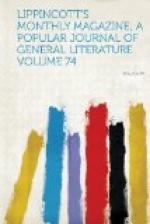block-houses, and found the date on the dismounted
gun to be more than a hundred years old.
The view was beautiful and the air fresh and fragrant
with scent of flowers.
But to return to our drive. I could gaze and gaze for ever at this lovely panorama, but am told this is the ugliest part of the road. The road itself is certainly not pretty just here, and is cloudy with a fine red dust, but this view of sea and distant hills is enchanting. Soon we get under the lee of the great mountain, and then its sheltering arms show their protective power; for splendid oak avenues begin to border the road all the way, and miniature forests of straight-stemmed pines and shimmering belts of the ghostly silver tree run up all the mountain-clefts. Stem and leaf of the silver tree are all of purest white; and when one gets a gleam of sunlight on a distant patch of these trees, the effect is quite indescribable, contrasting, as they do, with green of field and vineyard. The vines all about here and towards Constantia, thirteen miles off, are dwarf-plants, and only grow to the height of gooseberry-bushes. It is a particular species, which is found to answer best as requiring less labor to train and cultivate, and is less likely to be blown out of the ground by the violent “sou’-easters” which come sweeping over the mountain. These gales are evidently the greatest annoyance which Cape Colonists have to endure; and although everybody kindly suggests that I ought to see one, just to understand what it is like, I am profoundly thankful that I only know it from their description and my own distinct recollection of the New Zealand “nor’-westers.” Those were hot winds, scorching and curling up everything, whereas this is rather a cold breeze, although it blows chiefly in summer. It whirls along clouds of dust from the red clay roads and fields which penetrates and clings to everything in the most extraordinary manner. All along the road the stems and lower branches of the trees are dyed a deep brick-dust color, and I hear moving and pathetic stories of how it ruins clothes, not only utterly spoiling black silk dresses, but staining white petticoats and children’s frocks and pinafores with a border of color exactly like the ruddle with which sheep are branded. Especially is it the terror of sailors, rendering the navigation along the coast dangerous and difficult; for it blends land and water into one indistinct whirl of vaporous cloud, confusing and blurring everything until one cannot distinguish shore from sea.
The vineyards of Constantia originally took their pretty name from the fair daughter of one of the early Dutch governors, but now it has grown into a generic word, and you see “Cloete’s Constantia,” “Von Reybeck Constantia,” written upon great stone gateways leading by long avenues into the various vine-growing plantations. It was to the former of these constantias, which was also the farthest off, that we were bound




